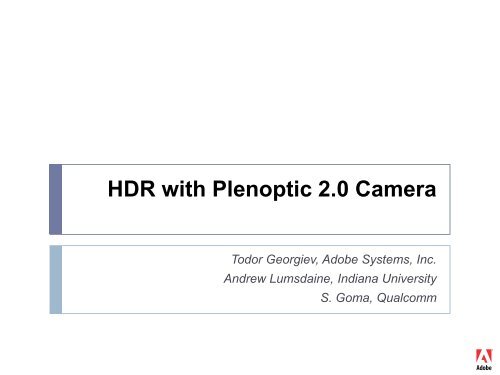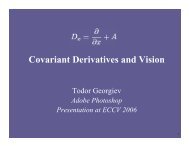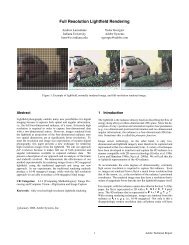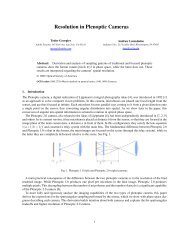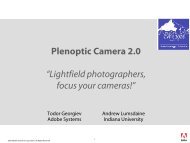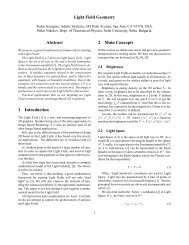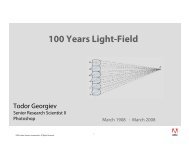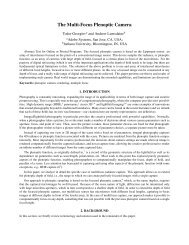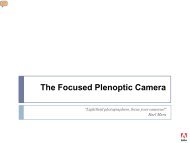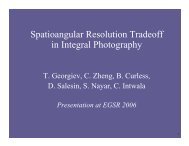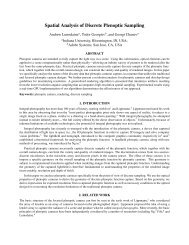Focused Plenoptic Camera - Todor Georgiev
Focused Plenoptic Camera - Todor Georgiev
Focused Plenoptic Camera - Todor Georgiev
You also want an ePaper? Increase the reach of your titles
YUMPU automatically turns print PDFs into web optimized ePapers that Google loves.
HDR with <strong>Plenoptic</strong> 2.0 <strong>Camera</strong><br />
<strong>Todor</strong> <strong>Georgiev</strong>, Adobe Systems, Inc.<br />
Andrew Lumsdaine, Indiana University<br />
S. Goma, Qualcomm
Overview<br />
<strong>Plenoptic</strong> cameras capture the 4D radiance<br />
Recently developed plenoptic camera 2.0 has<br />
significantly higher resolution than 1.0<br />
It records a multiplicity of focused images<br />
We can sample the radiance function flexibly and in<br />
extended ways<br />
Simultaneously sample with different apertures<br />
HDR with a single snapshot (i.e. dynamic scenes)
<strong>Plenoptic</strong> <strong>Camera</strong>, Adelson 1992<br />
Main lens focused on microlenses
<strong>Focused</strong> <strong>Plenoptic</strong> <strong>Camera</strong><br />
Microlenses focused on main lens image
Comparison<br />
<strong>Plenoptic</strong> <strong>Camera</strong> (1.0) <strong>Focused</strong> <strong>Plenoptic</strong> <strong>Camera</strong> (2.0)
Comparison<br />
<br />
<strong>Plenoptic</strong> <strong>Camera</strong><br />
<br />
<strong>Focused</strong> <strong>Plenoptic</strong> <strong>Camera</strong><br />
Microlenses focused at infinity.<br />
Completely defocused relative<br />
to main lens image.<br />
Microlenses satisfy the lens<br />
equation. Exactly focused on<br />
the main lens image.
Comparison<br />
<br />
<strong>Plenoptic</strong> <strong>Camera</strong><br />
<br />
<strong>Focused</strong> <strong>Plenoptic</strong> <strong>Camera</strong><br />
Blurry microimages<br />
Sharp and inverted microimages
Why inverted images?<br />
Simple relay imaging! This is like a telescope with<br />
multiple eyepieces.
Lightfield Rendering Small Part of a Scene
<strong>Plenoptic</strong> 2.0 Rendering: 500X Improvement!
<strong>Plenoptic</strong> 2.0 Refocusing
<strong>Plenoptic</strong> 2.0 Refocusing
<strong>Plenoptic</strong> 2.0 Refocusing
<strong>Plenoptic</strong> 2.0 HDR
HDR with <strong>Plenoptic</strong> <strong>Camera</strong> 2.0<br />
Each point is seen multiple times in different microlenses<br />
We put different apertures on different microlenses
Apertures for <strong>Plenoptic</strong> <strong>Camera</strong> 2.0<br />
Microlenses are diffraction limited.<br />
Apertures should have low F-number to eliminate<br />
excessive diffraction blur.<br />
The big apertures should match F-number of main lens.<br />
Ratio of areas should be > 2.<br />
It would be nice to have more than 2 interleaved apertures.<br />
Focal length of microlenses 1.5mm due to cover glass.<br />
Microimages 500 microns correspond to F/3.<br />
Pixels 6.8 microns
Apertures for <strong>Plenoptic</strong> <strong>Camera</strong> 2.0<br />
We considered different apertures, that would be practical:<br />
1 2 3<br />
Our microlens array (choice 3) with black chromium<br />
apertures manufactured by Leister Axetris, Dec. 2008<br />
100 and 200 micron apertures, separated by 500 microns
Interleaved Apertures for <strong>Plenoptic</strong> 2.0
Interleaved Apertures for <strong>Plenoptic</strong> 2.0
20<br />
HDR (part of raw image with plenoptic<br />
2.0)
HDR with <strong>Plenoptic</strong> <strong>Camera</strong> 2.0<br />
We can put different filters on different microlenses:<br />
Neutral density, color (for spectral imaging), polarization.<br />
1000 X increase 12-color imaging sampling four<br />
in dynamic range with RGB sensor linear polarizations
Superresolution with <strong>Plenoptic</strong> 2.0 <strong>Camera</strong><br />
Each microlens is observing the scene as a slightly<br />
shifted camera. We can compute the subpixel shift<br />
based on camera parameters. Then, superresolve.
<strong>Plenoptic</strong> 2.0 HDR<br />
<strong>Plenoptic</strong> 2.0 sampling is more flexible:<br />
Decouples resolution from number of microlenses<br />
Allows radiance to be sampled more flexibly<br />
Precise alignment between neighboring images & superres.<br />
Varying apertures in the microlens array allows<br />
simultaneous capture of the scene at different f-stops<br />
High Dynamic Range can be captured in a single<br />
snapshot (dynamic scenes can be captured)
The End


